University of Western Sydney: Epidemiology Assessment 2, Spring 2019
VerifiedAdded on 2022/10/09
|10
|2887
|18
Homework Assignment
AI Summary
This document presents solutions to an epidemiology assessment, analyzing a study on domestic violence and its association with preterm or low birthweight delivery in Vietnam. It addresses questions on study design, exposure and outcome measures, selection bias, and crude odds ratios. The assignment also explores a case-control study on birth defects and folic acid supplements, calculating and interpreting measures of association. Furthermore, it examines a cohort study investigating the effect of a rare exposure on disease, assessing crude and stratified associations, confounding factors, and attributable risk. The solutions provide detailed interpretations of the findings, including the impact of age as a confounder and the implications for public health interventions, offering a comprehensive understanding of epidemiological concepts and their application in real-world scenarios.

Introduction to Epidemiology
Paraphrase This Document
Need a fresh take? Get an instant paraphrase of this document with our AI Paraphraser
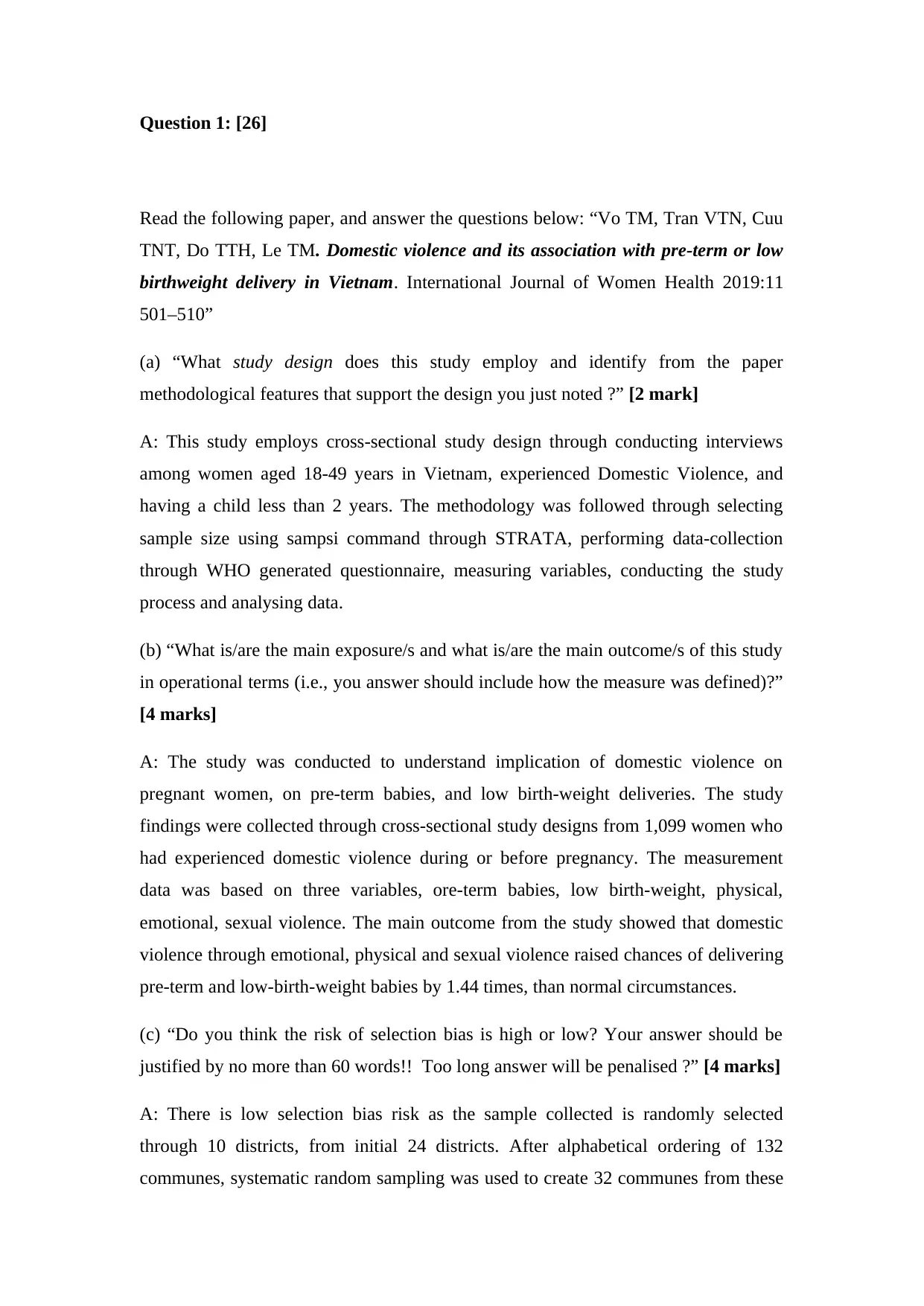
Question 1: [26]
Read the following paper, and answer the questions below: “Vo TM, Tran VTN, Cuu
TNT, Do TTH, Le TM. Domestic violence and its association with pre-term or low
birthweight delivery in Vietnam. International Journal of Women Health 2019:11
501–510”
(a) “What study design does this study employ and identify from the paper
methodological features that support the design you just noted ?” [2 mark]
A: This study employs cross-sectional study design through conducting interviews
among women aged 18-49 years in Vietnam, experienced Domestic Violence, and
having a child less than 2 years. The methodology was followed through selecting
sample size using sampsi command through STRATA, performing data-collection
through WHO generated questionnaire, measuring variables, conducting the study
process and analysing data.
(b) “What is/are the main exposure/s and what is/are the main outcome/s of this study
in operational terms (i.e., you answer should include how the measure was defined)?”
[4 marks]
A: The study was conducted to understand implication of domestic violence on
pregnant women, on pre-term babies, and low birth-weight deliveries. The study
findings were collected through cross-sectional study designs from 1,099 women who
had experienced domestic violence during or before pregnancy. The measurement
data was based on three variables, ore-term babies, low birth-weight, physical,
emotional, sexual violence. The main outcome from the study showed that domestic
violence through emotional, physical and sexual violence raised chances of delivering
pre-term and low-birth-weight babies by 1.44 times, than normal circumstances.
(c) “Do you think the risk of selection bias is high or low? Your answer should be
justified by no more than 60 words!! Too long answer will be penalised ?” [4 marks]
A: There is low selection bias risk as the sample collected is randomly selected
through 10 districts, from initial 24 districts. After alphabetical ordering of 132
communes, systematic random sampling was used to create 32 communes from these
Read the following paper, and answer the questions below: “Vo TM, Tran VTN, Cuu
TNT, Do TTH, Le TM. Domestic violence and its association with pre-term or low
birthweight delivery in Vietnam. International Journal of Women Health 2019:11
501–510”
(a) “What study design does this study employ and identify from the paper
methodological features that support the design you just noted ?” [2 mark]
A: This study employs cross-sectional study design through conducting interviews
among women aged 18-49 years in Vietnam, experienced Domestic Violence, and
having a child less than 2 years. The methodology was followed through selecting
sample size using sampsi command through STRATA, performing data-collection
through WHO generated questionnaire, measuring variables, conducting the study
process and analysing data.
(b) “What is/are the main exposure/s and what is/are the main outcome/s of this study
in operational terms (i.e., you answer should include how the measure was defined)?”
[4 marks]
A: The study was conducted to understand implication of domestic violence on
pregnant women, on pre-term babies, and low birth-weight deliveries. The study
findings were collected through cross-sectional study designs from 1,099 women who
had experienced domestic violence during or before pregnancy. The measurement
data was based on three variables, ore-term babies, low birth-weight, physical,
emotional, sexual violence. The main outcome from the study showed that domestic
violence through emotional, physical and sexual violence raised chances of delivering
pre-term and low-birth-weight babies by 1.44 times, than normal circumstances.
(c) “Do you think the risk of selection bias is high or low? Your answer should be
justified by no more than 60 words!! Too long answer will be penalised ?” [4 marks]
A: There is low selection bias risk as the sample collected is randomly selected
through 10 districts, from initial 24 districts. After alphabetical ordering of 132
communes, systematic random sampling was used to create 32 communes from these
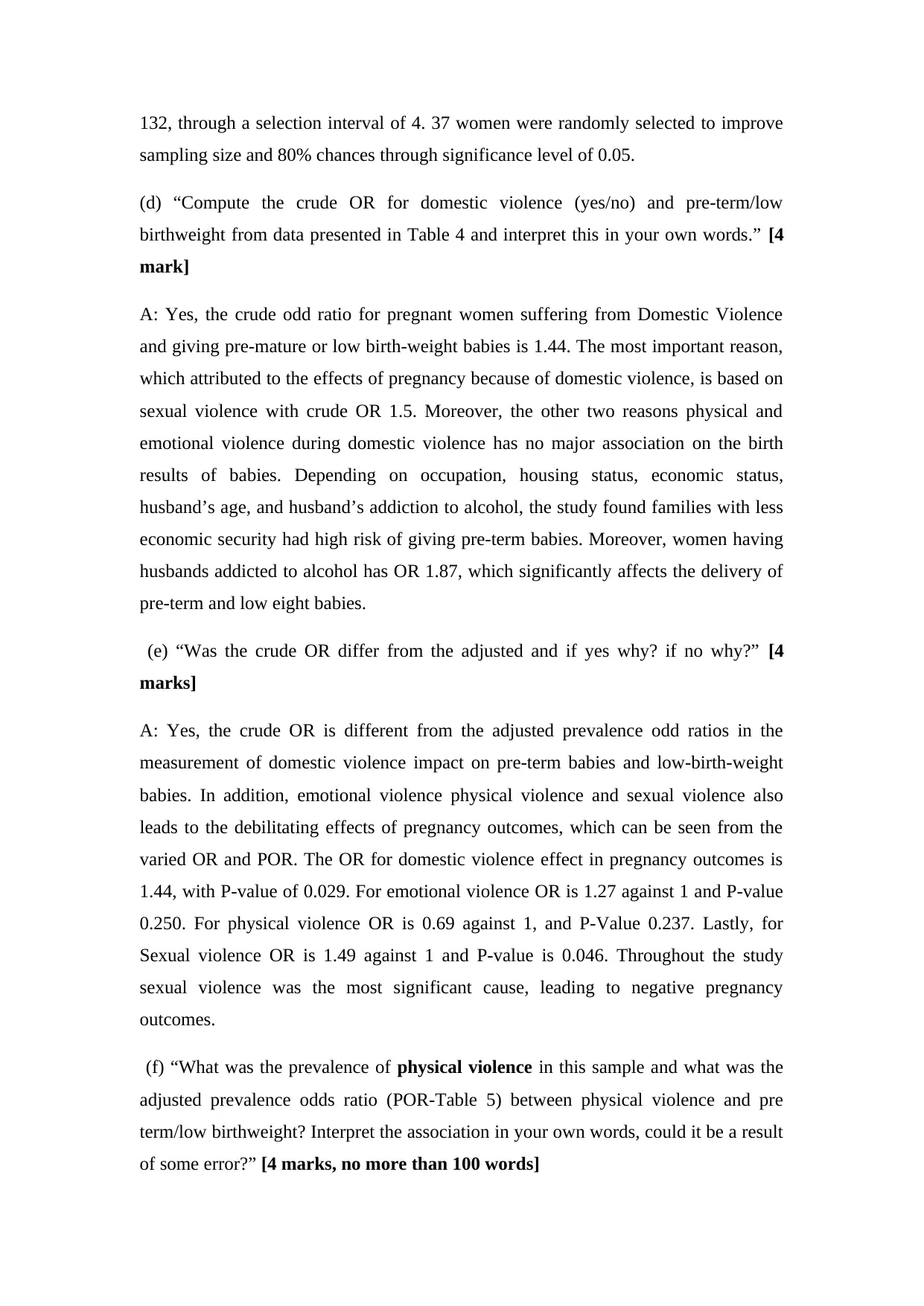
132, through a selection interval of 4. 37 women were randomly selected to improve
sampling size and 80% chances through significance level of 0.05.
(d) “Compute the crude OR for domestic violence (yes/no) and pre-term/low
birthweight from data presented in Table 4 and interpret this in your own words.” [4
mark]
A: Yes, the crude odd ratio for pregnant women suffering from Domestic Violence
and giving pre-mature or low birth-weight babies is 1.44. The most important reason,
which attributed to the effects of pregnancy because of domestic violence, is based on
sexual violence with crude OR 1.5. Moreover, the other two reasons physical and
emotional violence during domestic violence has no major association on the birth
results of babies. Depending on occupation, housing status, economic status,
husband’s age, and husband’s addiction to alcohol, the study found families with less
economic security had high risk of giving pre-term babies. Moreover, women having
husbands addicted to alcohol has OR 1.87, which significantly affects the delivery of
pre-term and low eight babies.
(e) “Was the crude OR differ from the adjusted and if yes why? if no why?” [4
marks]
A: Yes, the crude OR is different from the adjusted prevalence odd ratios in the
measurement of domestic violence impact on pre-term babies and low-birth-weight
babies. In addition, emotional violence physical violence and sexual violence also
leads to the debilitating effects of pregnancy outcomes, which can be seen from the
varied OR and POR. The OR for domestic violence effect in pregnancy outcomes is
1.44, with P-value of 0.029. For emotional violence OR is 1.27 against 1 and P-value
0.250. For physical violence OR is 0.69 against 1, and P-Value 0.237. Lastly, for
Sexual violence OR is 1.49 against 1 and P-value is 0.046. Throughout the study
sexual violence was the most significant cause, leading to negative pregnancy
outcomes.
(f) “What was the prevalence of physical violence in this sample and what was the
adjusted prevalence odds ratio (POR-Table 5) between physical violence and pre
term/low birthweight? Interpret the association in your own words, could it be a result
of some error?” [4 marks, no more than 100 words]
sampling size and 80% chances through significance level of 0.05.
(d) “Compute the crude OR for domestic violence (yes/no) and pre-term/low
birthweight from data presented in Table 4 and interpret this in your own words.” [4
mark]
A: Yes, the crude odd ratio for pregnant women suffering from Domestic Violence
and giving pre-mature or low birth-weight babies is 1.44. The most important reason,
which attributed to the effects of pregnancy because of domestic violence, is based on
sexual violence with crude OR 1.5. Moreover, the other two reasons physical and
emotional violence during domestic violence has no major association on the birth
results of babies. Depending on occupation, housing status, economic status,
husband’s age, and husband’s addiction to alcohol, the study found families with less
economic security had high risk of giving pre-term babies. Moreover, women having
husbands addicted to alcohol has OR 1.87, which significantly affects the delivery of
pre-term and low eight babies.
(e) “Was the crude OR differ from the adjusted and if yes why? if no why?” [4
marks]
A: Yes, the crude OR is different from the adjusted prevalence odd ratios in the
measurement of domestic violence impact on pre-term babies and low-birth-weight
babies. In addition, emotional violence physical violence and sexual violence also
leads to the debilitating effects of pregnancy outcomes, which can be seen from the
varied OR and POR. The OR for domestic violence effect in pregnancy outcomes is
1.44, with P-value of 0.029. For emotional violence OR is 1.27 against 1 and P-value
0.250. For physical violence OR is 0.69 against 1, and P-Value 0.237. Lastly, for
Sexual violence OR is 1.49 against 1 and P-value is 0.046. Throughout the study
sexual violence was the most significant cause, leading to negative pregnancy
outcomes.
(f) “What was the prevalence of physical violence in this sample and what was the
adjusted prevalence odds ratio (POR-Table 5) between physical violence and pre
term/low birthweight? Interpret the association in your own words, could it be a result
of some error?” [4 marks, no more than 100 words]
⊘ This is a preview!⊘
Do you want full access?
Subscribe today to unlock all pages.

Trusted by 1+ million students worldwide
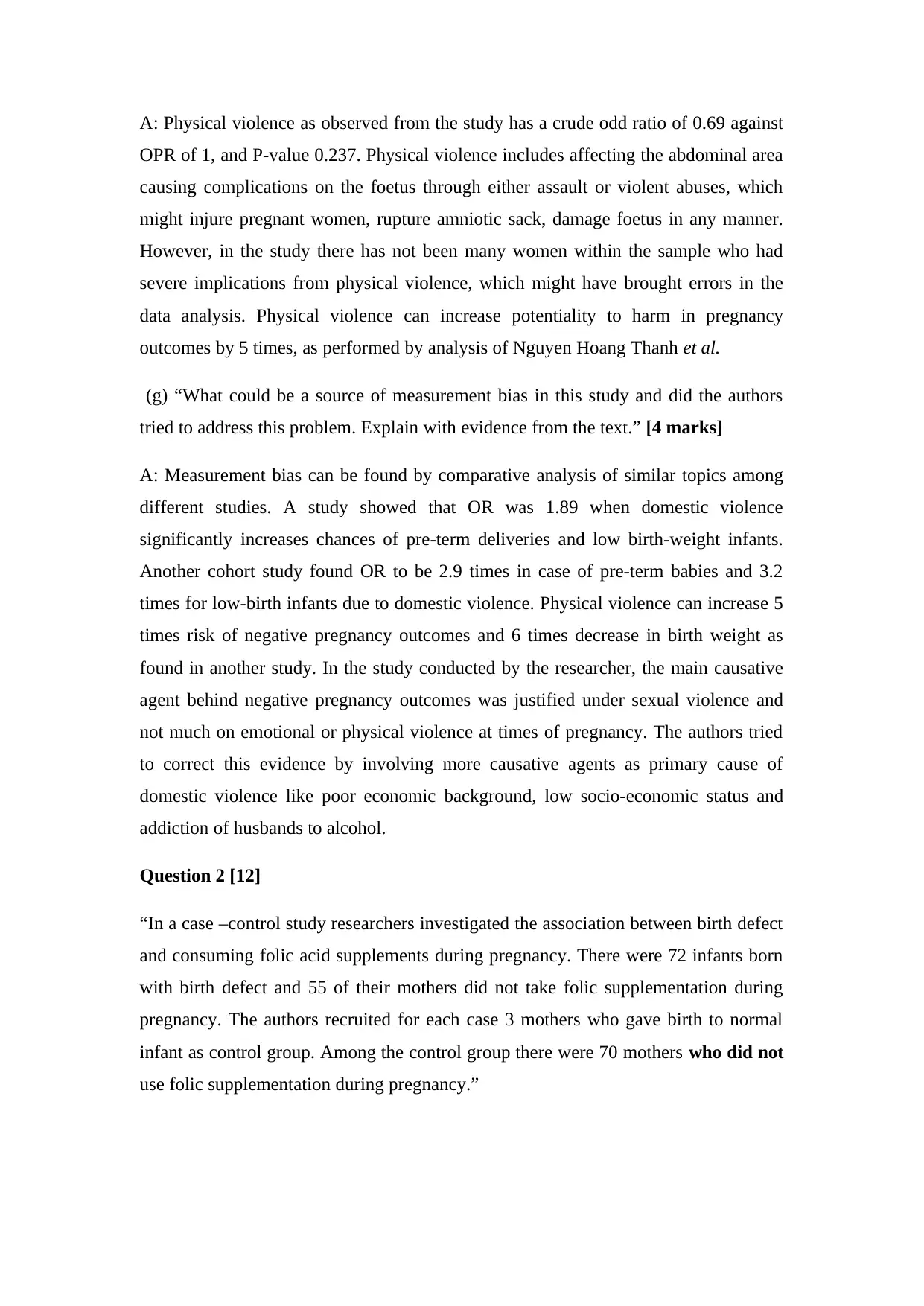
A: Physical violence as observed from the study has a crude odd ratio of 0.69 against
OPR of 1, and P-value 0.237. Physical violence includes affecting the abdominal area
causing complications on the foetus through either assault or violent abuses, which
might injure pregnant women, rupture amniotic sack, damage foetus in any manner.
However, in the study there has not been many women within the sample who had
severe implications from physical violence, which might have brought errors in the
data analysis. Physical violence can increase potentiality to harm in pregnancy
outcomes by 5 times, as performed by analysis of Nguyen Hoang Thanh et al.
(g) “What could be a source of measurement bias in this study and did the authors
tried to address this problem. Explain with evidence from the text.” [4 marks]
A: Measurement bias can be found by comparative analysis of similar topics among
different studies. A study showed that OR was 1.89 when domestic violence
significantly increases chances of pre-term deliveries and low birth-weight infants.
Another cohort study found OR to be 2.9 times in case of pre-term babies and 3.2
times for low-birth infants due to domestic violence. Physical violence can increase 5
times risk of negative pregnancy outcomes and 6 times decrease in birth weight as
found in another study. In the study conducted by the researcher, the main causative
agent behind negative pregnancy outcomes was justified under sexual violence and
not much on emotional or physical violence at times of pregnancy. The authors tried
to correct this evidence by involving more causative agents as primary cause of
domestic violence like poor economic background, low socio-economic status and
addiction of husbands to alcohol.
Question 2 [12]
“In a case –control study researchers investigated the association between birth defect
and consuming folic acid supplements during pregnancy. There were 72 infants born
with birth defect and 55 of their mothers did not take folic supplementation during
pregnancy. The authors recruited for each case 3 mothers who gave birth to normal
infant as control group. Among the control group there were 70 mothers who did not
use folic supplementation during pregnancy.”
OPR of 1, and P-value 0.237. Physical violence includes affecting the abdominal area
causing complications on the foetus through either assault or violent abuses, which
might injure pregnant women, rupture amniotic sack, damage foetus in any manner.
However, in the study there has not been many women within the sample who had
severe implications from physical violence, which might have brought errors in the
data analysis. Physical violence can increase potentiality to harm in pregnancy
outcomes by 5 times, as performed by analysis of Nguyen Hoang Thanh et al.
(g) “What could be a source of measurement bias in this study and did the authors
tried to address this problem. Explain with evidence from the text.” [4 marks]
A: Measurement bias can be found by comparative analysis of similar topics among
different studies. A study showed that OR was 1.89 when domestic violence
significantly increases chances of pre-term deliveries and low birth-weight infants.
Another cohort study found OR to be 2.9 times in case of pre-term babies and 3.2
times for low-birth infants due to domestic violence. Physical violence can increase 5
times risk of negative pregnancy outcomes and 6 times decrease in birth weight as
found in another study. In the study conducted by the researcher, the main causative
agent behind negative pregnancy outcomes was justified under sexual violence and
not much on emotional or physical violence at times of pregnancy. The authors tried
to correct this evidence by involving more causative agents as primary cause of
domestic violence like poor economic background, low socio-economic status and
addiction of husbands to alcohol.
Question 2 [12]
“In a case –control study researchers investigated the association between birth defect
and consuming folic acid supplements during pregnancy. There were 72 infants born
with birth defect and 55 of their mothers did not take folic supplementation during
pregnancy. The authors recruited for each case 3 mothers who gave birth to normal
infant as control group. Among the control group there were 70 mothers who did not
use folic supplementation during pregnancy.”
Paraphrase This Document
Need a fresh take? Get an instant paraphrase of this document with our AI Paraphraser
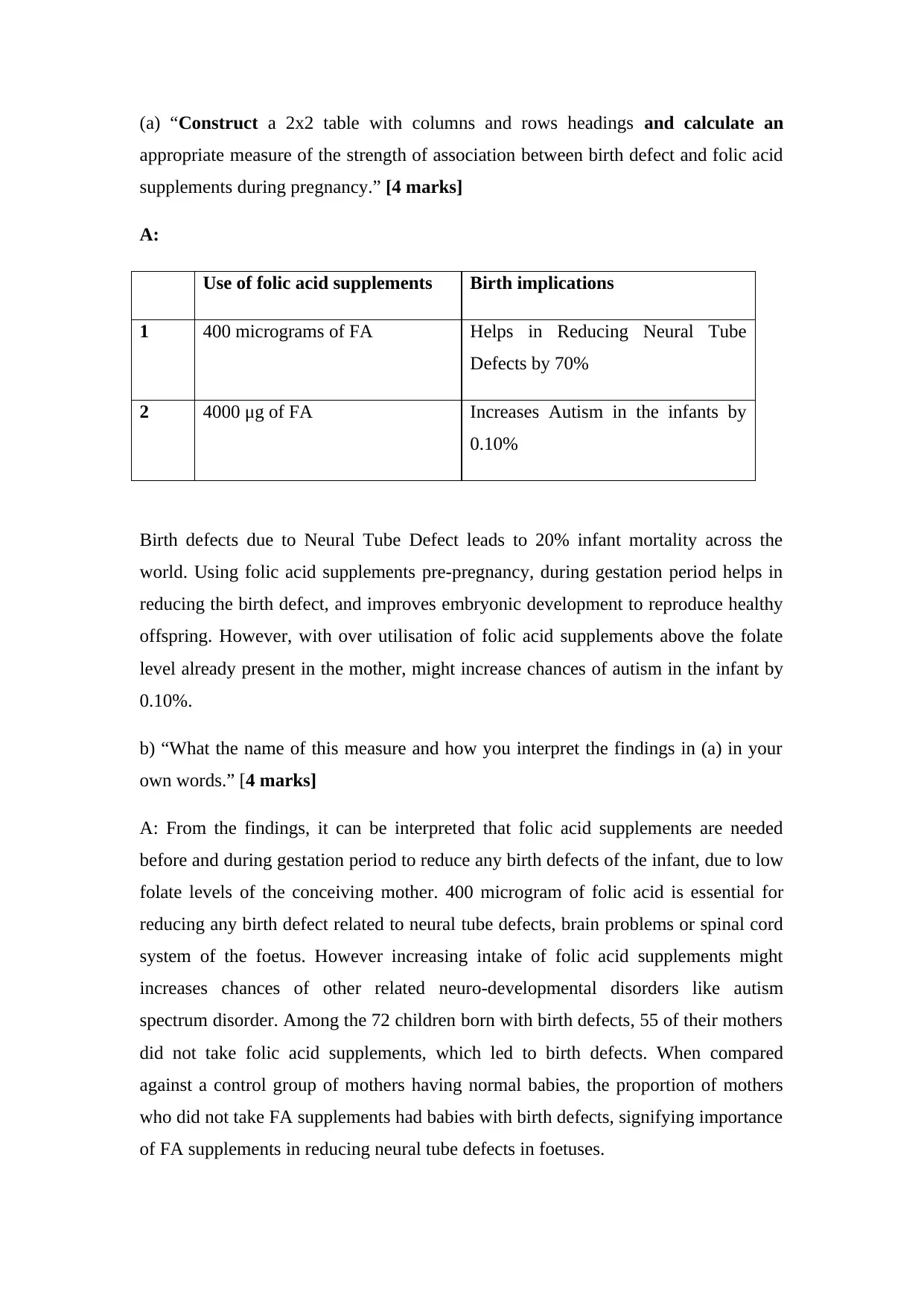
(a) “Construct a 2x2 table with columns and rows headings and calculate an
appropriate measure of the strength of association between birth defect and folic acid
supplements during pregnancy.” [4 marks]
A:
Use of folic acid supplements Birth implications
1 400 micrograms of FA Helps in Reducing Neural Tube
Defects by 70%
2 4000 μg of FA Increases Autism in the infants by
0.10%
Birth defects due to Neural Tube Defect leads to 20% infant mortality across the
world. Using folic acid supplements pre-pregnancy, during gestation period helps in
reducing the birth defect, and improves embryonic development to reproduce healthy
offspring. However, with over utilisation of folic acid supplements above the folate
level already present in the mother, might increase chances of autism in the infant by
0.10%.
b) “What the name of this measure and how you interpret the findings in (a) in your
own words.” [4 marks]
A: From the findings, it can be interpreted that folic acid supplements are needed
before and during gestation period to reduce any birth defects of the infant, due to low
folate levels of the conceiving mother. 400 microgram of folic acid is essential for
reducing any birth defect related to neural tube defects, brain problems or spinal cord
system of the foetus. However increasing intake of folic acid supplements might
increases chances of other related neuro-developmental disorders like autism
spectrum disorder. Among the 72 children born with birth defects, 55 of their mothers
did not take folic acid supplements, which led to birth defects. When compared
against a control group of mothers having normal babies, the proportion of mothers
who did not take FA supplements had babies with birth defects, signifying importance
of FA supplements in reducing neural tube defects in foetuses.
appropriate measure of the strength of association between birth defect and folic acid
supplements during pregnancy.” [4 marks]
A:
Use of folic acid supplements Birth implications
1 400 micrograms of FA Helps in Reducing Neural Tube
Defects by 70%
2 4000 μg of FA Increases Autism in the infants by
0.10%
Birth defects due to Neural Tube Defect leads to 20% infant mortality across the
world. Using folic acid supplements pre-pregnancy, during gestation period helps in
reducing the birth defect, and improves embryonic development to reproduce healthy
offspring. However, with over utilisation of folic acid supplements above the folate
level already present in the mother, might increase chances of autism in the infant by
0.10%.
b) “What the name of this measure and how you interpret the findings in (a) in your
own words.” [4 marks]
A: From the findings, it can be interpreted that folic acid supplements are needed
before and during gestation period to reduce any birth defects of the infant, due to low
folate levels of the conceiving mother. 400 microgram of folic acid is essential for
reducing any birth defect related to neural tube defects, brain problems or spinal cord
system of the foetus. However increasing intake of folic acid supplements might
increases chances of other related neuro-developmental disorders like autism
spectrum disorder. Among the 72 children born with birth defects, 55 of their mothers
did not take folic acid supplements, which led to birth defects. When compared
against a control group of mothers having normal babies, the proportion of mothers
who did not take FA supplements had babies with birth defects, signifying importance
of FA supplements in reducing neural tube defects in foetuses.
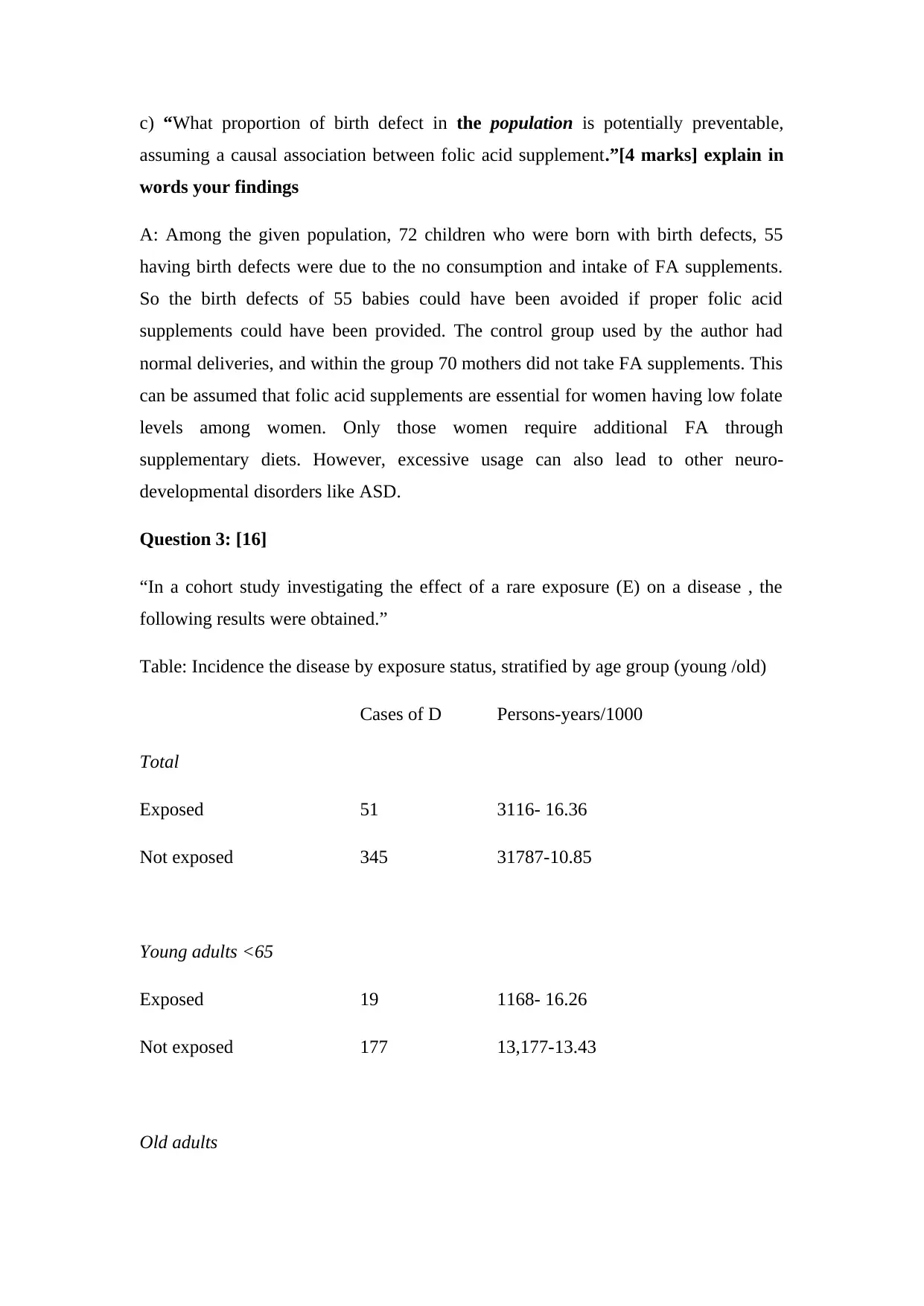
c) “What proportion of birth defect in the population is potentially preventable,
assuming a causal association between folic acid supplement.”[4 marks] explain in
words your findings
A: Among the given population, 72 children who were born with birth defects, 55
having birth defects were due to the no consumption and intake of FA supplements.
So the birth defects of 55 babies could have been avoided if proper folic acid
supplements could have been provided. The control group used by the author had
normal deliveries, and within the group 70 mothers did not take FA supplements. This
can be assumed that folic acid supplements are essential for women having low folate
levels among women. Only those women require additional FA through
supplementary diets. However, excessive usage can also lead to other neuro-
developmental disorders like ASD.
Question 3: [16]
“In a cohort study investigating the effect of a rare exposure (E) on a disease , the
following results were obtained.”
Table: Incidence the disease by exposure status, stratified by age group (young /old)
Cases of D Persons-years/1000
Total
Exposed 51 3116- 16.36
Not exposed 345 31787-10.85
Young adults <65
Exposed 19 1168- 16.26
Not exposed 177 13,177-13.43
Old adults
assuming a causal association between folic acid supplement.”[4 marks] explain in
words your findings
A: Among the given population, 72 children who were born with birth defects, 55
having birth defects were due to the no consumption and intake of FA supplements.
So the birth defects of 55 babies could have been avoided if proper folic acid
supplements could have been provided. The control group used by the author had
normal deliveries, and within the group 70 mothers did not take FA supplements. This
can be assumed that folic acid supplements are essential for women having low folate
levels among women. Only those women require additional FA through
supplementary diets. However, excessive usage can also lead to other neuro-
developmental disorders like ASD.
Question 3: [16]
“In a cohort study investigating the effect of a rare exposure (E) on a disease , the
following results were obtained.”
Table: Incidence the disease by exposure status, stratified by age group (young /old)
Cases of D Persons-years/1000
Total
Exposed 51 3116- 16.36
Not exposed 345 31787-10.85
Young adults <65
Exposed 19 1168- 16.26
Not exposed 177 13,177-13.43
Old adults
⊘ This is a preview!⊘
Do you want full access?
Subscribe today to unlock all pages.

Trusted by 1+ million students worldwide
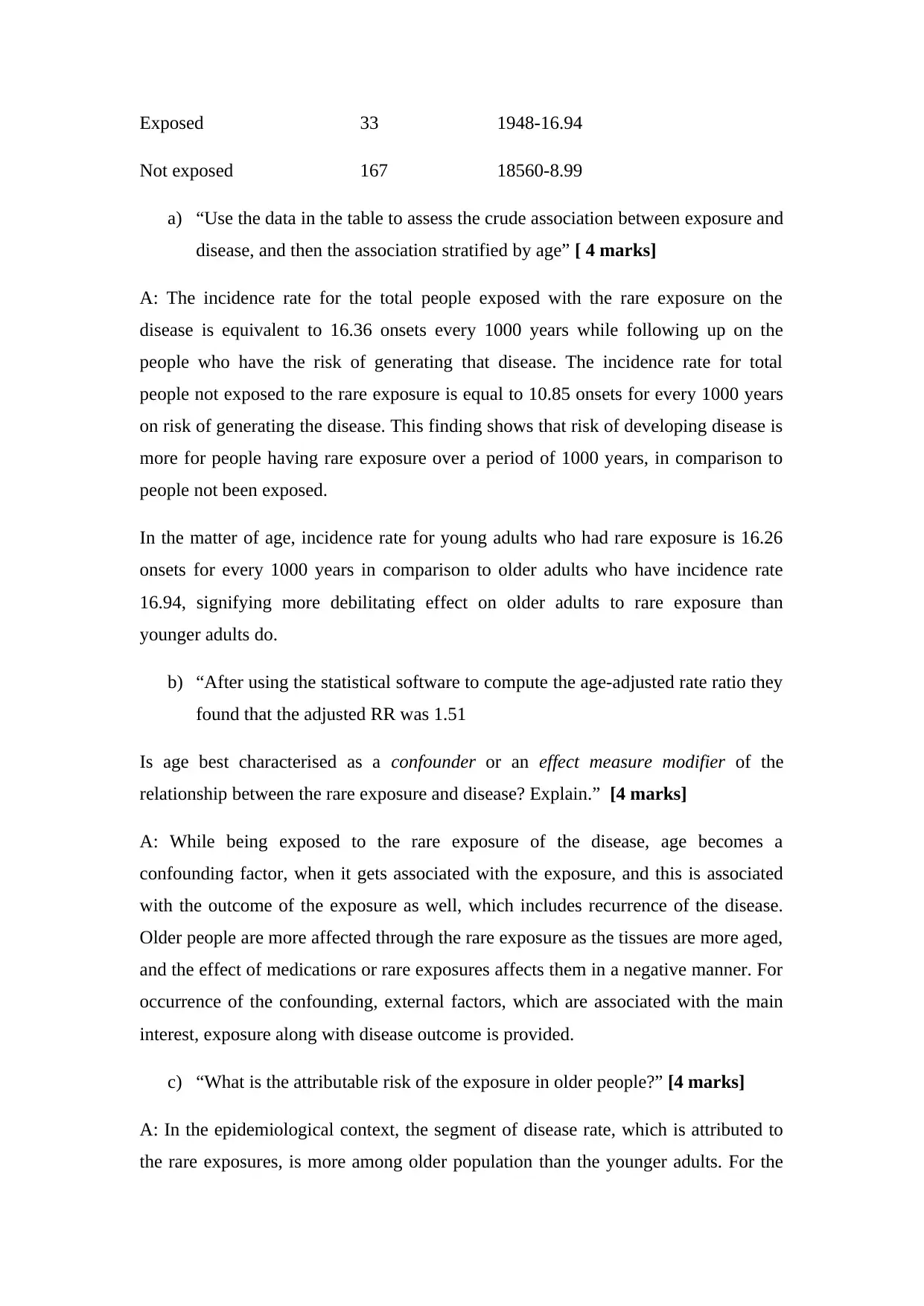
Exposed 33 1948-16.94
Not exposed 167 18560-8.99
a) “Use the data in the table to assess the crude association between exposure and
disease, and then the association stratified by age” [ 4 marks]
A: The incidence rate for the total people exposed with the rare exposure on the
disease is equivalent to 16.36 onsets every 1000 years while following up on the
people who have the risk of generating that disease. The incidence rate for total
people not exposed to the rare exposure is equal to 10.85 onsets for every 1000 years
on risk of generating the disease. This finding shows that risk of developing disease is
more for people having rare exposure over a period of 1000 years, in comparison to
people not been exposed.
In the matter of age, incidence rate for young adults who had rare exposure is 16.26
onsets for every 1000 years in comparison to older adults who have incidence rate
16.94, signifying more debilitating effect on older adults to rare exposure than
younger adults do.
b) “After using the statistical software to compute the age-adjusted rate ratio they
found that the adjusted RR was 1.51
Is age best characterised as a confounder or an effect measure modifier of the
relationship between the rare exposure and disease? Explain.” [4 marks]
A: While being exposed to the rare exposure of the disease, age becomes a
confounding factor, when it gets associated with the exposure, and this is associated
with the outcome of the exposure as well, which includes recurrence of the disease.
Older people are more affected through the rare exposure as the tissues are more aged,
and the effect of medications or rare exposures affects them in a negative manner. For
occurrence of the confounding, external factors, which are associated with the main
interest, exposure along with disease outcome is provided.
c) “What is the attributable risk of the exposure in older people?” [4 marks]
A: In the epidemiological context, the segment of disease rate, which is attributed to
the rare exposures, is more among older population than the younger adults. For the
Not exposed 167 18560-8.99
a) “Use the data in the table to assess the crude association between exposure and
disease, and then the association stratified by age” [ 4 marks]
A: The incidence rate for the total people exposed with the rare exposure on the
disease is equivalent to 16.36 onsets every 1000 years while following up on the
people who have the risk of generating that disease. The incidence rate for total
people not exposed to the rare exposure is equal to 10.85 onsets for every 1000 years
on risk of generating the disease. This finding shows that risk of developing disease is
more for people having rare exposure over a period of 1000 years, in comparison to
people not been exposed.
In the matter of age, incidence rate for young adults who had rare exposure is 16.26
onsets for every 1000 years in comparison to older adults who have incidence rate
16.94, signifying more debilitating effect on older adults to rare exposure than
younger adults do.
b) “After using the statistical software to compute the age-adjusted rate ratio they
found that the adjusted RR was 1.51
Is age best characterised as a confounder or an effect measure modifier of the
relationship between the rare exposure and disease? Explain.” [4 marks]
A: While being exposed to the rare exposure of the disease, age becomes a
confounding factor, when it gets associated with the exposure, and this is associated
with the outcome of the exposure as well, which includes recurrence of the disease.
Older people are more affected through the rare exposure as the tissues are more aged,
and the effect of medications or rare exposures affects them in a negative manner. For
occurrence of the confounding, external factors, which are associated with the main
interest, exposure along with disease outcome is provided.
c) “What is the attributable risk of the exposure in older people?” [4 marks]
A: In the epidemiological context, the segment of disease rate, which is attributed to
the rare exposures, is more among older population than the younger adults. For the
Paraphrase This Document
Need a fresh take? Get an instant paraphrase of this document with our AI Paraphraser
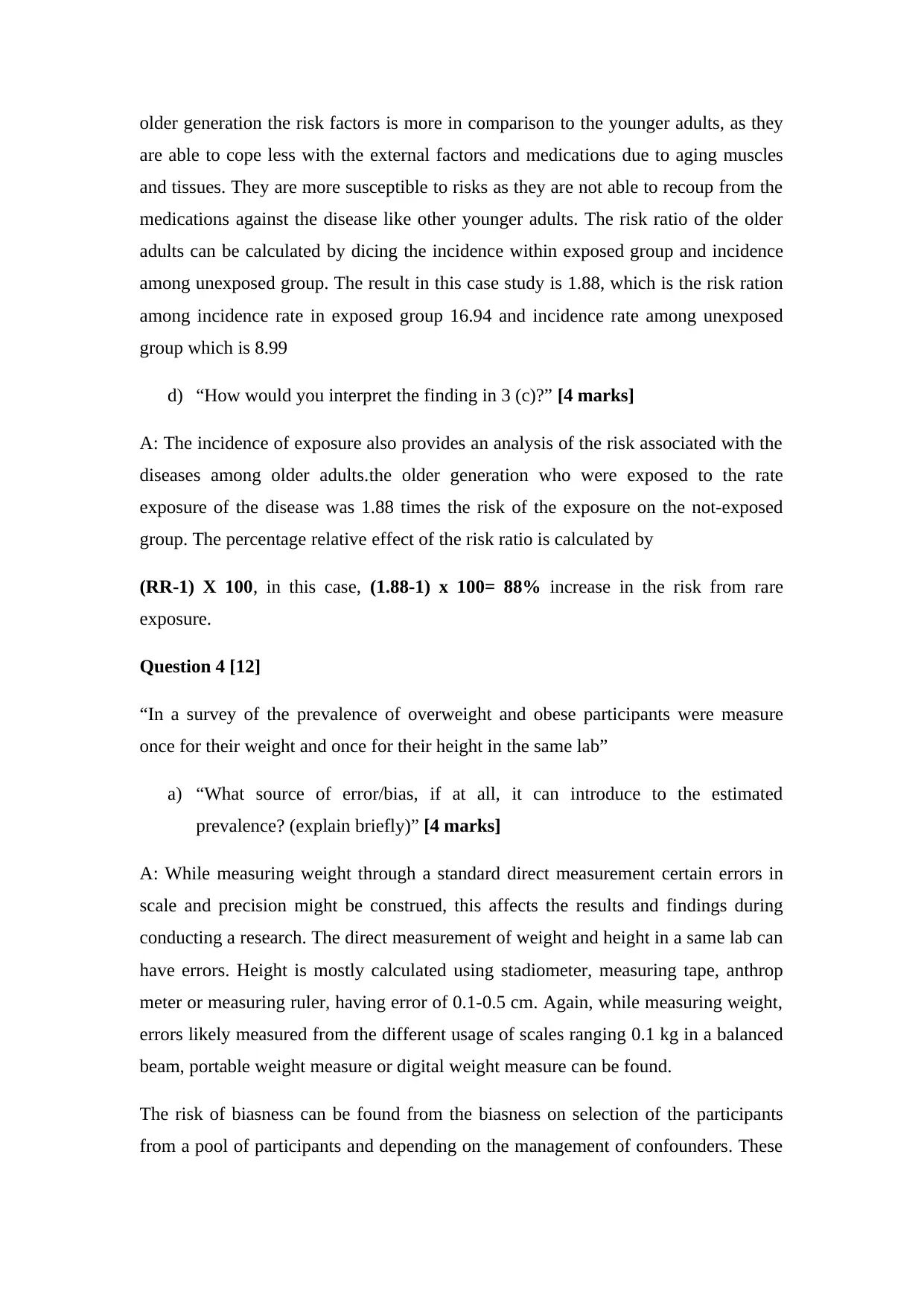
older generation the risk factors is more in comparison to the younger adults, as they
are able to cope less with the external factors and medications due to aging muscles
and tissues. They are more susceptible to risks as they are not able to recoup from the
medications against the disease like other younger adults. The risk ratio of the older
adults can be calculated by dicing the incidence within exposed group and incidence
among unexposed group. The result in this case study is 1.88, which is the risk ration
among incidence rate in exposed group 16.94 and incidence rate among unexposed
group which is 8.99
d) “How would you interpret the finding in 3 (c)?” [4 marks]
A: The incidence of exposure also provides an analysis of the risk associated with the
diseases among older adults.the older generation who were exposed to the rate
exposure of the disease was 1.88 times the risk of the exposure on the not-exposed
group. The percentage relative effect of the risk ratio is calculated by
(RR-1) X 100, in this case, (1.88-1) x 100= 88% increase in the risk from rare
exposure.
Question 4 [12]
“In a survey of the prevalence of overweight and obese participants were measure
once for their weight and once for their height in the same lab”
a) “What source of error/bias, if at all, it can introduce to the estimated
prevalence? (explain briefly)” [4 marks]
A: While measuring weight through a standard direct measurement certain errors in
scale and precision might be construed, this affects the results and findings during
conducting a research. The direct measurement of weight and height in a same lab can
have errors. Height is mostly calculated using stadiometer, measuring tape, anthrop
meter or measuring ruler, having error of 0.1-0.5 cm. Again, while measuring weight,
errors likely measured from the different usage of scales ranging 0.1 kg in a balanced
beam, portable weight measure or digital weight measure can be found.
The risk of biasness can be found from the biasness on selection of the participants
from a pool of participants and depending on the management of confounders. These
are able to cope less with the external factors and medications due to aging muscles
and tissues. They are more susceptible to risks as they are not able to recoup from the
medications against the disease like other younger adults. The risk ratio of the older
adults can be calculated by dicing the incidence within exposed group and incidence
among unexposed group. The result in this case study is 1.88, which is the risk ration
among incidence rate in exposed group 16.94 and incidence rate among unexposed
group which is 8.99
d) “How would you interpret the finding in 3 (c)?” [4 marks]
A: The incidence of exposure also provides an analysis of the risk associated with the
diseases among older adults.the older generation who were exposed to the rate
exposure of the disease was 1.88 times the risk of the exposure on the not-exposed
group. The percentage relative effect of the risk ratio is calculated by
(RR-1) X 100, in this case, (1.88-1) x 100= 88% increase in the risk from rare
exposure.
Question 4 [12]
“In a survey of the prevalence of overweight and obese participants were measure
once for their weight and once for their height in the same lab”
a) “What source of error/bias, if at all, it can introduce to the estimated
prevalence? (explain briefly)” [4 marks]
A: While measuring weight through a standard direct measurement certain errors in
scale and precision might be construed, this affects the results and findings during
conducting a research. The direct measurement of weight and height in a same lab can
have errors. Height is mostly calculated using stadiometer, measuring tape, anthrop
meter or measuring ruler, having error of 0.1-0.5 cm. Again, while measuring weight,
errors likely measured from the different usage of scales ranging 0.1 kg in a balanced
beam, portable weight measure or digital weight measure can be found.
The risk of biasness can be found from the biasness on selection of the participants
from a pool of participants and depending on the management of confounders. These
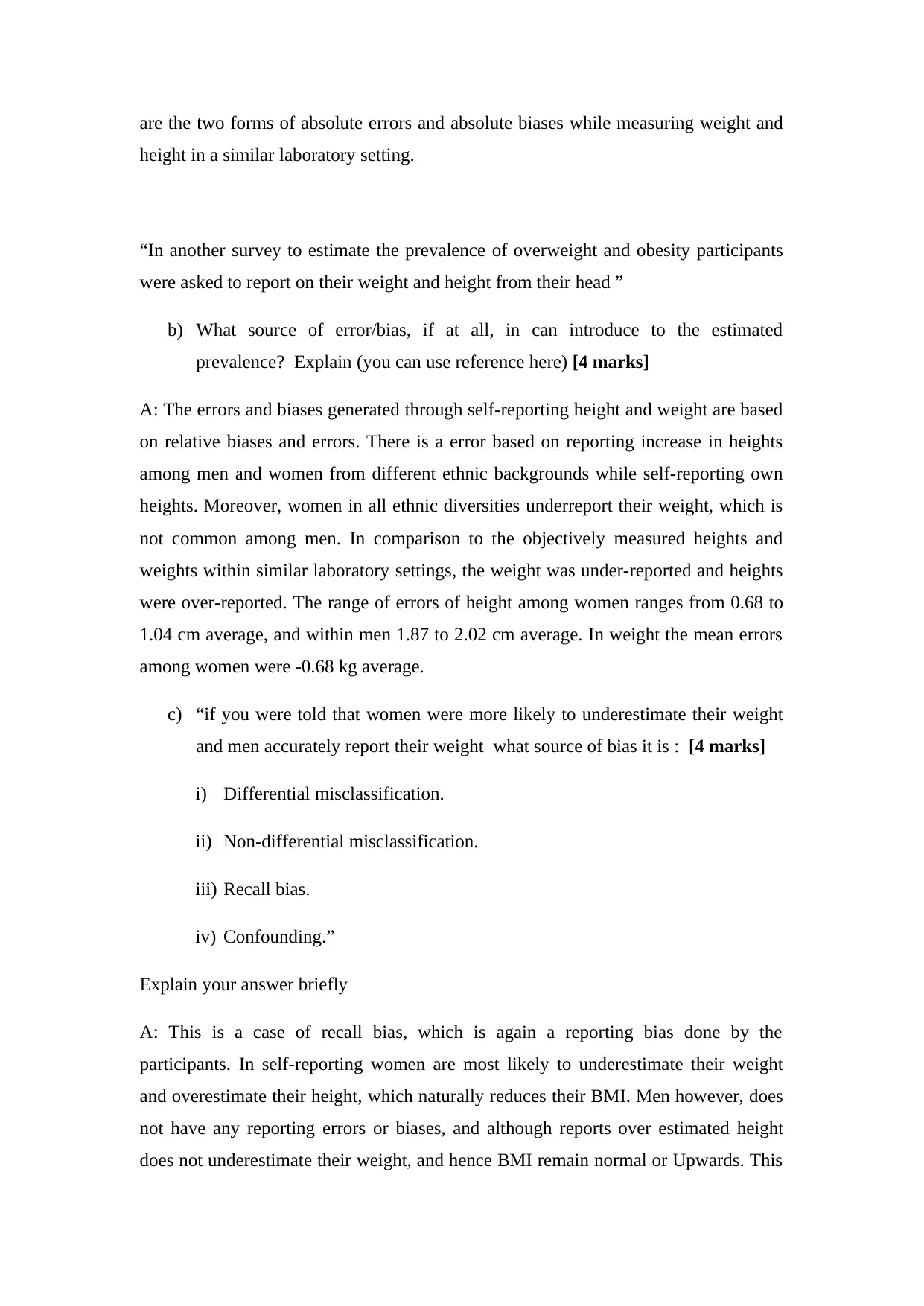
are the two forms of absolute errors and absolute biases while measuring weight and
height in a similar laboratory setting.
“In another survey to estimate the prevalence of overweight and obesity participants
were asked to report on their weight and height from their head ”
b) What source of error/bias, if at all, in can introduce to the estimated
prevalence? Explain (you can use reference here) [4 marks]
A: The errors and biases generated through self-reporting height and weight are based
on relative biases and errors. There is a error based on reporting increase in heights
among men and women from different ethnic backgrounds while self-reporting own
heights. Moreover, women in all ethnic diversities underreport their weight, which is
not common among men. In comparison to the objectively measured heights and
weights within similar laboratory settings, the weight was under-reported and heights
were over-reported. The range of errors of height among women ranges from 0.68 to
1.04 cm average, and within men 1.87 to 2.02 cm average. In weight the mean errors
among women were -0.68 kg average.
c) “if you were told that women were more likely to underestimate their weight
and men accurately report their weight what source of bias it is : [4 marks]
i) Differential misclassification.
ii) Non-differential misclassification.
iii) Recall bias.
iv) Confounding.”
Explain your answer briefly
A: This is a case of recall bias, which is again a reporting bias done by the
participants. In self-reporting women are most likely to underestimate their weight
and overestimate their height, which naturally reduces their BMI. Men however, does
not have any reporting errors or biases, and although reports over estimated height
does not underestimate their weight, and hence BMI remain normal or Upwards. This
height in a similar laboratory setting.
“In another survey to estimate the prevalence of overweight and obesity participants
were asked to report on their weight and height from their head ”
b) What source of error/bias, if at all, in can introduce to the estimated
prevalence? Explain (you can use reference here) [4 marks]
A: The errors and biases generated through self-reporting height and weight are based
on relative biases and errors. There is a error based on reporting increase in heights
among men and women from different ethnic backgrounds while self-reporting own
heights. Moreover, women in all ethnic diversities underreport their weight, which is
not common among men. In comparison to the objectively measured heights and
weights within similar laboratory settings, the weight was under-reported and heights
were over-reported. The range of errors of height among women ranges from 0.68 to
1.04 cm average, and within men 1.87 to 2.02 cm average. In weight the mean errors
among women were -0.68 kg average.
c) “if you were told that women were more likely to underestimate their weight
and men accurately report their weight what source of bias it is : [4 marks]
i) Differential misclassification.
ii) Non-differential misclassification.
iii) Recall bias.
iv) Confounding.”
Explain your answer briefly
A: This is a case of recall bias, which is again a reporting bias done by the
participants. In self-reporting women are most likely to underestimate their weight
and overestimate their height, which naturally reduces their BMI. Men however, does
not have any reporting errors or biases, and although reports over estimated height
does not underestimate their weight, and hence BMI remain normal or Upwards. This
⊘ This is a preview!⊘
Do you want full access?
Subscribe today to unlock all pages.

Trusted by 1+ million students worldwide

leads to misclassifying exposure data, which causes errors in the epidemiological
study. Exaggeration or lessening data can cause error in the actual data, increasing
errors in the actual findings of the research.
study. Exaggeration or lessening data can cause error in the actual data, increasing
errors in the actual findings of the research.
1 out of 10
Related Documents
Your All-in-One AI-Powered Toolkit for Academic Success.
+13062052269
info@desklib.com
Available 24*7 on WhatsApp / Email
![[object Object]](/_next/static/media/star-bottom.7253800d.svg)
Unlock your academic potential
Copyright © 2020–2025 A2Z Services. All Rights Reserved. Developed and managed by ZUCOL.





